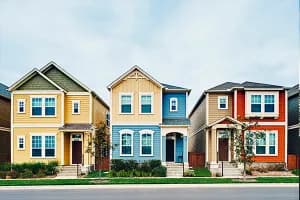
Knocking on wood is a superstition intended to bring good luck. Coincidentally, wood flooring improves the odds that a listing will appeal to more buyerspdf and increase its value.
Wood flooring’s increased pervasiveness in homes reflects its long-term durability, inherent natural character and warmth, low risk of allergens, and range of aesthetic choices that suit almost any decor. In fact, a wood floor can play a starring role in any room’s decor, which is why New York City–based designer Karen Asprea of Karen Asprea Studio makes flooring her first design decision when tackling a project.
Wood is also a draw for buyers seeking low-maintenance options, says Jennifer Ames, a sales associate with Engel & Volkers in Chicago. However, when colors or designs are out of date, it can derail a sale. “Buyers don’t want to have to refinish old boards, or worse, take the time to install new floors,” she says.
Because installing and refinishing wood floors is an expensive undertaking, homeowners should carefully weigh all choices, says Brett Miller, vice president of education and certification for the National Wood Flooring Association in suburban St. Louis.
As you’re guiding clients who are preparing their homes for sale or buyers who are brainstorming renovations, offer them information on today’s wood flooring design trends and product improvements.
Width. In recent years, manufacturers have made wider boards available—up to 24 inches, which can add to the cost. “No width is better than another; it depends on the aesthetic and budget,” says Jessica Lagrange, who heads Chicago-based Jessica Lagrange Interiors, a luxury interior design firm. “Because of a greater range of widths, homeowners can create any kind of decorative style—from traditional to contemporary and everything in between—as well as achieve a seamless look.” Narrower widths look more traditional while wider planks give a more modern aesthetic. “Wider widths also yield fewer seams and may look more appropriate in expansive spaces,” she says. Some designers suggest mixing widths for a novel look, though the downside can be a busy appearance, says K. Tyler, a partner in interior design at Morgante Wilson Architects, also in Chicago.
Length. Longer planks are also in vogue, sometimes 10 feet in length, which are ideal for large spaces, says Zack Clavin, strategic project manager for Bona, manufacturer of products for hardwood. Shorter planks can look choppy, especially if the grain isn’t consistent, says Lagrange. “They take stains differently, too, creating a variegated look that can be unattractive because it’s too busy,” she adds.
Species. Oak—and particularly domestic white oak—remains the most popular choice because it’s a hard material that can be resanded multiple times and accepts finishes and colors well. It can be cut in a rift, quarter sawn, or live sawn pattern, each revealing the wood’s different types of grain, says John Lessick, owner of Chicago-based Apex Wood Floors, a high-end wood contractor. Walnut follows as a second favorite choice, with softer woods such as hickory, beech, and pine less popular. For a contemporary vibe, Tyler suggests ash or maple.
Color. Most extremes have gone by the wayside, whether it’s the darkest ebony, which tends to reveal every scratch and piece of dog hair, or the lightest Scandinavian-style white and palest gray that have been popular as of late. For a safe, timeless look that will appeal to the largest group of buyers, Clavin suggests sellers consider a warm honey hue or a custom color develop by a professional. New finishes today can help keep shades from turning yellow or pink over time, which they did in the past, says Tom Segal, a Chicago-based designer with Kaufman-Segal Design.
Decorative features. Inlays such as medallions and borders are passé, except in very traditional homes and certain rooms or hallways. A better way to personalize a wood floor is to lay boards in a chevron or hexagonal pattern, crafted from small hardwood parquet strips fitted together. Similar strips arranged in tile-style squares—popular in the 1950s and 60s—are making a comeback among some home owners, though in a larger 24-by-24-inch scale, says Asprea. Texture can also be introduced through hand scraping or wire brushing. To play up a wood floor, New York City–based architect Joe Eisner likes to use wood in other places to coordinate, such as on walls, bedroom headboards, or in his own furniture designs. The downside of any personalization is that it narrows the buyer pool.
Beyond the living room. Homeowners are installing wood flooring all rooms of a home, even kitchens, powder rooms, and bedrooms where carpet and tile used to reign. “Many like the look of continuous wood throughout an interior,” says Tyler.
Manufactured technique. Homeowners today have more options when it comes to choosing their wood boards. Solid wood can be sanded numerous times either on site or before it’s installed. It also comes in myriad species. Engineered flooring consists of multiple layers of hardwood veneers glued and pressed together to improve stability, so the wood doesn’t expand and contract as much as solid wood, especially in humid weather. The thickness of the top layer will determine how often it can be sanded and the board’s quality, says Eisner. Another advantage is that it can be glued to a concrete slab, making it popular in multifamily high-rise buildings. Either type can be prefinished or customized on site. Lagrange prefers staining on site. “You have much more control over the hue when you do so,” she says. “But you need a skilled contractor to achieve a specific shade.” Price is determined by several factors, from the quality of the wood to the skills of the manufacturer and wood contractor.
Finish. Gone are the days when homeowners have to vacate their home (or a room) for days due to noxious-smelling products previously used to seal a floor. Many finishes today dry quickly and are better for the environment with lower volatile organic compounds, Clavin says. More buyers favor a matte or low-sheen rather than high-gloss look, which also reveals fewer imperfections and dirt. “Dull is good,” Tyler says. This can be achieved with either a water-based or natural-oil finish. The prime difference is that they require different cleaning products afterward. If strong sunlight is a factor, buyers should be sure the product offers protection against ultraviolet light, so the wood won’t fade, says Jennifer Kamenca, vice president of design studio operations at Residential Design Services in Anaheim, Calif., which provides design services to builders. Real estate practitioner Stephanie Mallios, with the Stephanie Mallios Team at Coldwell Banker Residential Brokerage in Short Hills, N.J., often tells clients to consult a flooring expert to assess condition of a wood floor before taking on a refinishing or replacement project. NWFA and Bona each list skilled refinishers by area.









